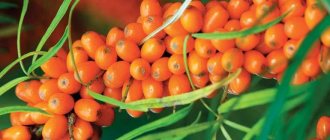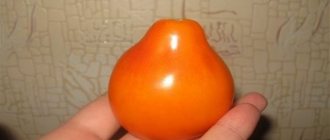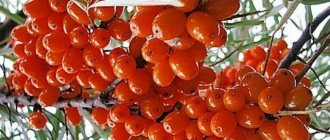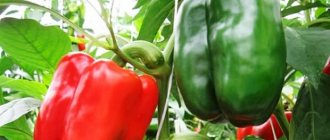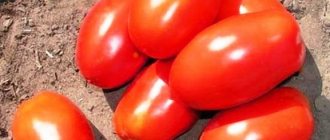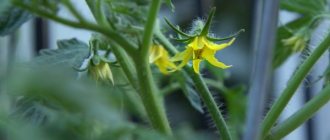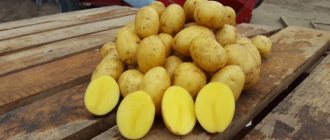The sea buckthorn variety Essel is a large-fruited representative of this magnificent crop. It has long been known in gardening circles and is very popular. Essel is grown not only in “home” gardens, but also in commercial lands. The variety has high taste qualities, so the demand for it is only increasing.
Main characteristics
Sea buckthorn is a real storehouse of nutrients and vitamins. Its use is extremely beneficial for the human body. Therefore, the culture can often be found in gardens and vegetable gardens, as well as in home areas.
The Essel variety can be used as an element of landscape design.
The natural habitat of sea buckthorn is Siberia. However, today, thanks to the work of breeders, the plant has spread throughout the country and is successfully grown in various latitudes.
The description of Essel sea buckthorn dates back to the end of the 20th century. The variety was obtained in 1986 at the Research Institute named after M.A. Lisavenko in the Altai Territory. A team of talented breeders worked on its creation, whose authorship also includes the sea buckthorn varieties Azhurnaya, Altaiskaya, Augustina and others.
To breed Essel, the method of free pollination of large-fruited elite forms of the plant was used. The result was a sea buckthorn variety characterized by large fruits and good frost resistance. Essel is recommended for cultivation in the Western and Eastern Siberian regions, however, it can also grow in other regions.
Sea buckthorn Essel is a medium-sized deciduous shrub with a compact, spherical, non-thickened crown. The trunk is tree-like, the shoots are straight, of medium thickness. There is a relatively small number of small spines.
The leaves are long, elongated, of medium thickness. Dark green in color and concave in shape. Flowering precedes the appearance of foliage. It begins at the end of April - the first ten days of May. The flowers are regular, collected in inflorescences on very short stalks.
Sea buckthorn is a dioecious plant. This must be taken into account when planting shrubs on the site to produce fruit. Berries grow only on female plants. Therefore, male pollinating shrubs are planted nearby. For one “male” sea buckthorn there can be about 5 “female” bushes. They are planted either in a line or in a group. In this case, it is better to place the male plant in the center.
Pollination occurs mainly by wind rather than insects.
Female and male sea buckthorn are distinguished by their buds:
The shrub begins to bear fruit from the 4th year after planting in the ground. The fruits ripen in mid-August. They are quite large (1.5 cm in length and weighing 1.2 g), oval in shape and bright orange in color. The fruits come off the stems without effort. The yield is high and amounts to 10-12 kg per bush and 80 c per 1 ha.
The Essel variety is frost-resistant and can survive at temperatures as low as -25C. At the same time, resistance to drought and high temperatures is average. The plant has good immunity and can resist many common diseases and pests. However, if unfavorable environmental conditions develop, natural “protective barriers” weaken.
Varieties for Ukraine
The climate in most of Ukraine is much milder than in Russia. Accordingly, local gardeners can choose sea buckthorn varieties, focusing not on what is possible, but on what they want to grow. The defining characteristics in this case are the yield, the taste of the berries, and the presence of immunity against diseases and pests typical of the crop.
Elizabeth
Quite an old variety, bred in the 80s of the last century through chemical mutagenesis. The basis for the experiment was the seeds of sea buckthorn Panteleevskaya.
The bush is low, up to 2 m. The crown is sparse, almost regular spherical or oval in shape. The bark on adult shoots is brownish-brown. There are very few thorns. The leaves are small, concave.
Sea buckthorn Elizaveta was bred in Siberia, but is not particularly frost-resistant
The average weight of an elongated oval berry is 0.85–1 g. The skin is bright orange and thin. When torn from a branch, it is often damaged. The stalks are long. The berries, which literally cling to the shoots of most varieties of sea buckthorn, are located rather “loosely” on the branches of the Elizabeth bushes. The pulp is sweet and sour, very aromatic and juicy. The vitamin C content is low - 70–80 mg per 100 g.
Winter hardiness down to -20ºС, yield - 15–18 kg per bush. The fruits are valued for their versatility; they can also be consumed fresh. The variety does not make any special demands on soil quality and rarely suffers from diseases and pests.
Galerite
A variety of sea buckthorn that forms a very compact bush, and also does not differ in growth rate. Maximum height - up to 1.5 m. The crown is spreading, not thickened. The shoots are thin, curving.
The Galerit sea buckthorn bush is compact and can be planted even in the smallest garden plots.
The berries are ellipsoid, weighing about 0.8–0.9 g. The skin is shiny, pale orange, covered with spots of reddish-pink “blush”, mainly concentrated at the top and base of the fruit. The pulp is very dense, but tender and juicy, with a subtle bitter aftertaste.
The harvest ripens late, in the second ten days of September. Fruiting is stable, annual. The average yield is 10–12 kg per adult bush.
Essel
One of the latest achievements of breeders. The variety belongs to the early category; the berries ripen in the first ten days or closer to mid-August. The plant is tree-like, with a crown of a regular oval shape. There are almost no thorns.
Sea buckthorn dessert variety Essel is one of the latest achievements of breeders
The fruits are large, elongated, oval or egg-shaped, weighing 1–1.2 g. The skin is pale orange, the flesh is slightly darker. The pulp is very juicy and sweet, the sourness in the taste is almost invisible. The fruits are separated from the branches extremely easily. The average yield is 10–13 kg.
The variety belongs to the dessert category; the fruits can be consumed fresh. Winter hardiness is good, down to -25ºС. The berries are well suited for making juices.
Lady fingers
Also one of the new selections. The bush does not differ in size and growth rate. The fruits are elongated, weighing 1–1.3 g. The yield is low - 6–7 kg per bush. The taste earned the highest possible rating from professional tasters. A dessert variety, the purpose of the fruit is universal.
A new variety of sea buckthorn, Lady's Fingers, is considered the most delicious so far.
Taste and application
According to the description, Essel sea buckthorn is a dessert variety. Consumers highly value it because of the sweetness of the fruit and the large amount of useful substances it contains. Professional tasters rate the taste at 4.7 on a five-point scale.
The pulp is juicy, fleshy, very sweet with barely noticeable sourness. The level of sugars (glucose and fructose) in berries is 9.6%, and acids - 1.2%. Sea buckthorn is rich in vitamin C, carotene, folic acid, organic acids, tannins and fatty oils.
Essel fruits are recommended to be consumed fresh, since in this case they contain a maximum of useful substances. This variety of sea buckthorn also produces excellent juice. The fruits can be frozen or ground with sugar.
Features of cultivation
Sea buckthorn is a perennial plant. With proper care, it can bear fruit for 15-20 years. An important stage in the cultivation of this crop is the choice of a “permanent place of residence” for the shrub and agricultural technology during planting. By following a few simple rules, you can get an actively growing bush with regular fruiting.
Boarding time
It is best to plant sea buckthorn in early spring. April will be ideal for gardening: when the ground has already thawed, but the plants have not yet fully “woke up” after winter. When planting in autumn, there is a risk that the shrub will not have time to get stronger before the onset of cold weather and will not survive the winter.
Selection of planting material
It is best to buy Essel sea buckthorn in a specialized nursery. In this case, preference should be given to local producers who grow planting material adapted to a given climatic zone.
It is necessary to place sea buckthorn of both sexes in the garden.
Sea buckthorn is propagated vegetatively and by seeds. For planting, it is best to use a seedling obtained from cuttings. It takes root well and takes root quickly.
Selection of site and soil
Essel, like other sea buckthorn varieties, loves the sun. Therefore, for the bush you should choose a place that is not shaded by trees or tall buildings. The plant also does not tolerate cold winds. Accordingly, he will need a barrier from drafts. It is optimal to plant sea buckthorn along the fence, which will protect it from the wind. At the same time, the bushes will serve as decoration.
Sea buckthorn loves loose, drained sandy loam soils with neutral acidity. It is not recommended to plant the plant on clay soils. The landing site should not be located in a low area where water often collects. This can negatively affect the condition of the roots.
If clay soils predominate in the garden plot, then during planting sand is added to the hole in the proportion of 1 bucket per 1 m2.
Landing
The pit for sea buckthorn is prepared in advance. For spring planting - in autumn, for autumn - several weeks before the start of planting. A step-by-step description of the Essel planting procedure is as follows:
- Dig a hole 40 cm deep and with the same diameter. The top fertile layer is laid separately.
- A 5-7 cm layer of drainage is poured onto the bottom (crushed stone, broken brick, expanded clay, etc.) and a support (high stick) is installed.
- The hole is filled with soil mixture, which is prepared in the following proportion: 1 bucket of organic fertilizers (compost or humus) per 2 buckets of fertile soil and 150 g of superphosphate.
- The pit is covered with waterproof material and left alone.
- Immediately before planting the seedling, its roots are placed in water for about an hour. To disinfect the plant (as a preventive measure for the development of diseases), the roots are dipped for 1 minute in a solution of an insecticide from the class of organophosphorus compounds.
- The hole is dug about halfway and a small mound is made at the bottom. A root node is placed on it and the roots are carefully straightened in different directions. Add soil on top.
- It is necessary to ensure that the root collar is at ground level.
- The bush is tied to a support and a tree trunk circle is formed.
- Water with 2 buckets of water, which is added gradually, and mulch the tree trunk circle with mowed grass or compost.
- The top of the seedling is pinched to allow the bush to branch.
The most frost-resistant varieties
Sea buckthorn belongs to Siberian plants, so good frost resistance is its natural characteristic. But there are varieties in which this indicator is at the highest level.
golden cob
Frost-resistant sea buckthorn variety Golden Cob
A sea buckthorn variety that begins to bear fruit already in the 3rd year of life. A small number of spines can also be identified. Golden-orange berries weighing up to 0.5 grams are collected in dense clusters of cobs . The main advantage is increased winter hardiness.
Trofimovskaya
Sea buckthorn variety Trofimovskaya
Tall shrub with a spreading, umbrella-shaped form. It bears large fruits weighing up to 0.7 grams, orange in color with red tints . The shape of the berries is elongated. The variety is characterized by a high content of ascorbic acid. Trofimovskaya is able to survive not only winter cold, but also spring frosts, which are more destructive for most crops.
Botanical amateur
Sea buckthorn Botanical amateur
Shrub grows up to 4 meters in height, the crown has a pyramidal shape. The leaves are large, light green in color, and there are practically no spines. The berries ripen in early August, and if the harvest is not harvested on time, it will become overripe and become untransportable. The fruits are large, yellow-orange with scales. The shape is oval-cylindrical. The pulp has a pleasant taste and pineapple smell. also very productive; 15 kilograms of crops are harvested from one bush; sea buckthorn begins to bear fruit already at 3-4 years of age . Botanical amateur is resistant to frost, drought and various diseases.
Gift of Katun
Frost-resistant variety of sea buckthorn Dar Katuni
The bush grows up to 2.7 meters in height, the crown is oval, the density is average. There may be a small number of spines or they may be completely absent. The leaves are concave in shape and rich green in color. The fruits are orange in color and round in shape, with an average weight of 0.7 grams . The harvest can be harvested in the second half of August. Fruiting of sea buckthorn begins at the 3rd year of life and continues until the age of 12. 14-16 kilograms of harvest are harvested from one bush. The variety is resistant to frost and disease.
Sea buckthorn contains a large amount of vitamins and beneficial microelements , so such berries have a beneficial effect on the human body. Due to its high oil content, this culture is often used in cosmetology.
Care
According to reviews from experienced gardeners, Essel sea buckthorn is a relatively unpretentious plant. However, it requires appropriate care (especially in the first season after planting) so that the shrub can develop and bear fruit normally.
Watering
Essel does not need to be watered frequently. It is enough to perform 3-4 waterings per season:
- before flowering;
- after flowering;
- during fruit ripening, if there is drought;
- in the fall before wintering.
Under each bush, add 3-4 buckets of water and loosen the soil shallowly. After watering, the tree trunk circle is mulched.
The young seedling must be watered every week. If nature copes with watering itself (with the help of rain), then the soil should not be waterlogged.
Trimming
It is necessary to prune the bush every year in early spring. There are three types of pruning that are applicable for sea buckthorn:
- formative - the first 2-3 years, during which root shoots and branches that grow incorrectly are removed;
- sanitary – performed every year, remove dried, frozen and damaged branches;
- rejuvenating – carried out after about 7 years.
Top dressing
The fertilizers that were added to the planting hole will be enough for the bush for 1 year. Next season, sea buckthorn will require nitrogen fertilizers for shoot growth, which are applied before flowering.
In the future, nitrogen fertilizers are used for the fruiting plant before and after flowering. After harvesting, fertilize with superphosphate. Once every three years, organic matter is added to the soil in the fall.
Wintering
Sea buckthorn is frost-resistant. For the winter, it will be sufficient to mulch the tree trunk well. Essel can withstand frosts down to -25 C. If the region experiences lower temperatures, the plant will need to be covered. A young seedling also needs shelter in its first season. Burlap or agrofibre is used as a covering material.
It is necessary to remove snow from the branches, since under its weight they can break off.
The most productive thornless varieties
The productivity of sea buckthorn is influenced not only by weather conditions, but also by the correct choice of variety, soil nutrition, protection from diseases, rodents and pests. Yield varieties are grown for personal use and sale. They are found in small garden plots and farms.
Chuyskaya
The yield of the Chuyskaya variety is from 10 to 17 kg per bush, in favorable summers it reaches 23 kg. The plant is medium-sized, the crown is compact and round. The shoots are dark green, the leaves are curved. The shape of the berry is cylindrical-oval, weight is about 1 g. The color is yellow-orange, rich. The pulp is sweet and sour with a tart aftertaste.
Chuyskaya is drought- and frost-resistant, so it is suitable for growing in any region of Russia. To protect against pests, it is recommended to carry out preventive measures: weed and mulch the beds, apply mineral fertilizers.
Gift to the garden
The average crop yield is 20 kg per bush. The mid-season variety is planted in the Volga-Vyatka, Central, and Northwestern regions.
The tree is medium-sized with straight and thick shoots. The leaves are large, dark green. The average weight of the berry is 0.6 g, the shape is oval-elongated, the skin is dark orange and dense, so the crop can be stored for a long time and is suitable for transportation. The taste is sour, the flesh is pleasant and tart. The variety rarely gets sick and is frost-resistant.
Pearl oyster
Early fruiting variety - the first harvest is harvested 3 years after planting. One bush produces up to 15 kg of berries per season. The height of the plant is 2–2.5 m, the crown is oval, spines are very rare. The leaves are medium sized green. The berries are oval-round, bright orange with a long stalk. Sea buckthorn weighs about 0.6 g. The taste is sweet with a bright aroma. Tasting score: 4.7 points.
The pearl oyster does not fall off after ripening; during harvesting, the berries are easily separated from the bush. The culture is winter-hardy and tolerates drought and heat. Recommended for planting in the middle zone and West Siberian region.
Jam
Mid-season and versatile variety. Spreading bushes with an oval crown and dark green leaves. The berries are oval, average weight - 1 g, color orange with a reddish tint. The pulp is sweet and sour. The yield of Jamova is up to 17 kg per plant per season.
The variety is drought-resistant and winter-hardy. Thanks to their dense peel, the berries are stored after harvest and are suitable for long-distance transportation and sale.
Interesting! Jam sea buckthorn has a high oil content (10.2%). It is used in cooking, cosmetology, and medicine. The substance has anti-inflammatory and antibacterial effects.
The culture is zoned for the West and East Siberian regions.
Diseases and pests
Sea buckthorn Essel has good immunity. With proper care, the plant will not be susceptible to common diseases. Therefore, it is necessary to remove weeds from the tree trunk in a timely manner, loosen the soil and follow the watering regime.
The main enemy of the bush is the sea buckthorn fly. It can destroy 90% of the crop. Therefore, to prevent pest attacks in the garden, plants should be planted that attract the natural enemy of the fly - the ichneumon fly. These include umbrella plants - dill, coriander, caraway, etc. And when the first signs of disease appear, treat the plant with insecticides.
Reviews
Irina Filippovna, Rostov region: I bought two sea buckthorn bushes of the Essel variety (“father” and “mother”). Both got along well. 2nd year growing. There are no fruits yet. The first winter I covered the bushes completely for the winter. For this I will leave only the tree trunk circle mulched with peat. According to the description, the plant will have enough strength to survive frosts.
Tatyana Krut, Barnaul: The Essel variety is early ripening. The fruits are large and juicy, very sweet. The productivity of one bush is high. It is good to freeze the fruits by grinding them into a paste with sugar. The consistency is like ice cream.
Olga R., Orenburg: The sun is of great importance for the Essel variety. In shaded areas the bush does not grow very well and the berries are less sweet. I put a net over the fruits because birds like them, and they can ruin a good part of the harvest.
Varieties of sea buckthorn without shoots
Shoots are young shoots that the plant does not need. They slow down the development of bushes, reduce yields and cause diseases. There is especially a lot of growth in old gardens, where, in addition to sea buckthorn, cherries, raspberries, currants and other berries grow. Removing such shoots requires effort and time. To avoid unnecessary worries, gardeners choose varieties of sea buckthorn without thorns and shoots.
Chechek
Medium-sized, neat bushes also perform a decorative function. The crown is spreading, there are no thorns. The fruits are broadly oval, the weight of one is from 0.8 to 1 g. The pulp is sweet and sour with a high oil content (7.8%). The color is orange with a reddish blush at the calyx and base of the stalk. The average yield is 168.5 c/ha.
Chechek ripens in the first half of September. The variety is frost-resistant and unpretentious, therefore suitable for cultivation in Eastern Siberia and the Far East. To increase productivity, plants are sprayed against sea buckthorn fly.
Amber necklace
The bushes are of medium height, the crown is round and semi-spreading. The shoots are straight and thick, the leaves are large. The weight of the berry is 1–1.5 g, the taste is sweet and sour, tart. The yield of the Amber Necklace is up to 14 kg per bush, the first fruits are harvested in early September.
Advantages include resistance to diseases, pests and frost resistance. The variety is recommended for planting in the Ural region.
Druzhina
An early ripening universal variety for the Urals and Siberia. The bushes are weak-growing, the crown is compressed. The shoots are medium brown with a gray coating. The weight of the fruit is up to 0.7 g, the skin is smooth and shiny. The taste is sweet and sour, the pulp has a high content of vitamin C (167 mg%).
The harvest is used for freezing, processing and cooking. The variety does not require special care; it requires timely watering and fertilizers.
Star Trek
The trees are tall with a spreading and dense crown. There are very few thorns - harvesting without difficulty. The weight of the berry is about 1 g, the shape is oblong, the color is red-orange. The skin is of medium thickness, so the fruits are used for transportation. The taste is sweet and sour with a refreshing sea buckthorn aroma.
Star Trek is winter-hardy and heat-resistant, and is universal in use. Suitable for growing in Western Siberia.
